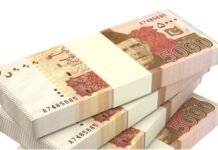KARACHI
The balance of payment figures rang an alarming bell for the economists as the country’s current account deficit (CAD) widened almost double to (negative) $ 2.601 billion in July, August 2017-18 compared to a deficit of $ 1.287 billion in the same period last year, the data released by the State Bank of Pakistan (SBP) said here on Tuesday.
Pakistan’s current account deficit was $550 million in August 2017.
The analyst says, “The current A/C deficit widened only because of rising country’s imports bills and lower inflows of remittances and foreign direct investment (FDI).” The CAD widened almost double in last two months.
Despite all weak indicators, the SBP figures show that the country’s Gross Domestic Product (GDP) surged by 10.72 per cent to $ 56.784 billion in last two months compared to $ 50.675 billion in the same period last fiscal year. According to the SBP’s projection, full-year GDP would remain around 6 per cent in the current fiscal year.
As a result of rising CAD, the foreign exchange (FX) reserves have been under pressure and are down by 9 per cent since June 2017 to $ 14.7 billion with the State Bank, which covers 3-months of imports.
The analysts forecast the CAD during 2017-18 to be in the range of $ 16.0-16.5 billion (5.0 per cent – 5.5 per cent of GDP), up from $ 4.9 billion in 2015-16 and $ 12.1 billion in 2016-17.
The sources in State Bank and senior economists are of the view that the government will likely arrange this funding through borrowing. During the outgoing year 2016-17, the government borrowed around $ 8.5 billion (public and private debt) to fund the country’s external gap.
Taking on additional short-term debt is a temporary measure and is not a sustainable situation. The new government after elections in 2018-19 will need to take strict measures to curtail the trade balance otherwise there will be no option but to seek IMF funding, the analysts said. Such measures will include Rupee devaluation, hike interest rates, duties on non-essential imports, incentives for exporters etc, he added.
The import bills had touched $ 8.982 billion in past two months which is almost above the double of the local export’s inflows, the SBP’s data said.
The central bank, from March this year, has imposed 100 per cent cash margin condition on the import of all luxurious items and imported vehicles. This decision of the SBP is supposed to control the local import’s bill, the analyst claimed.
Commenting on Moody’s rating for Pakistan, the analyst said that the country has hardly three-and-a-half months import bill amount, which it has to provide in shape of L/Cs, food import bills, edible oil import bills and crude oil bills.
The State Bank is facing payment pressure of international donor agencies including the International Monetary Fund (IMF). The central bank has so far maintained exchange rates in the interbank market despite pressure on the dollar. Now it is being traded in the interbank market at Rs 105.40 today compared with $ 104.83 in May 2016.
Continuing its rising trajectory, country’s trade deficit was further stretched by 34 per cent during last two month of 2017-18 to $ 6.3 billion against $ 4.7 billion owing to rise in imports and slow export growth, the analyst said. The much-hyped textile package has so far proven ineffective in providing sufficient respite, he added.
As per data reported by PBS, exports rose by 12 per cent YoY during July-Aug 2017-18 likely due to a surge in food and textile groups.
On the contrary, imports escalated by 25 per cent YoY in July-Aug 2017-18, where petroleum and machinery groups are expected to be the major precedents once detailed break-up is released, the analyst claimed.
The analyst said the machinery and petroleum imports are likely to continue rising on the back of ongoing infrastructural developments, and energy projects. Moreover, petroleum demand is also expected to remain robust owing to growing automobile sales, lower fuel prices, and higher infrastructure development activities.
























